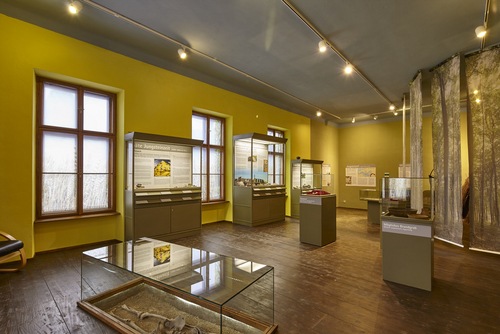Archeology was one of the great passions of Johann Krahuletz.
He was able to recover finds from every locality in the area. His favorite sites were the Vitusberg near Eggenburg and the Heidenstatt near Limberg.
Krahuletz thus laid the foundation for one of the most important and extensive prehistoric collections in Eastern Austria.
The oldest finds date from the Paleolithic. The arc spans the entire prehistoric and early history to the early Middle Ages. Remains from the Middle Ages and the modern era complete the cultural development of the region.
The “yurt” from Grubgraben
The people of the Palaeolithic lived as hunters and gatherers in the Lower Austrian tundra. During excavations in the Grubgraben near Kammern near Krems, remains of a 19,000 year old dwelling were found. In the Krahuletz Museum is a model of this unique finding to see.
Clay pots of the Lengyel culture
The Lengyel culture of the Middle Neolithic (about 4800 – 3000 BC) is characterized by a variety of ceramic vessels, which were all painted colorful, from. Predominantly the colors were red, white and yellow. In addition to large pots for stockpiling you knew already fine-walled tableware, such as various bowls and cups. Particularly striking are large, flat bowls on high, tubular clay feet.
Bridle from Mödring
The “Bridle of Mödring” is one of the icons of Waldviertel’s early history research and a unique find for Austria. It is a bronze bridle with bridle chains from the Roman Empire and was discovered in 1902 at Kienstockgraben in Mödring near Horn. A little later, Johann Krahuletz was able to acquire the piece for the museum. Interestingly, the main distribution of this type of harness in southern Sweden, the Mödringer Fund indicates a high mobility of individual populations during the Roman Empire.
Aquamanile
 Hand washing pot at the table in the form of a horse from the 13th century. In the Middle Ages one usually ate with the fingers; Forks were not used because they were considered tools of the devil. In order to be able to clean their hands after the meal one put in wealthy households Aquamanile (Latin, “Handwäscher”) on the tables.
Hand washing pot at the table in the form of a horse from the 13th century. In the Middle Ages one usually ate with the fingers; Forks were not used because they were considered tools of the devil. In order to be able to clean their hands after the meal one put in wealthy households Aquamanile (Latin, “Handwäscher”) on the tables.




